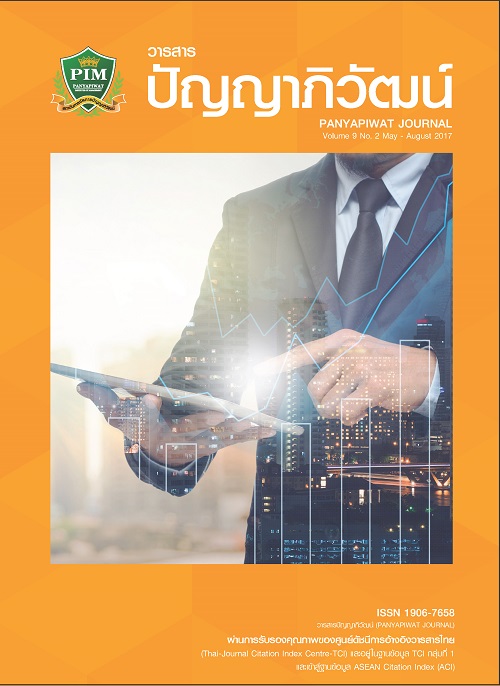การศึกษารูปแบบภาษาที่ใช้ในการแสดงระดับความมั่นใจในการเขียนเรียงความภาษาอังกฤษของนักศึกษา
Main Article Content
Abstract
งานวิจัยชิ้นนี้เป็นการศึกษาการใช้รูปแบบภาษาในการแสดงระดับความมั่นใจในการเขียนเรียงความภาษาอังกฤษของนักศึกษาเพื่อประเมินประสิทธิภาพในการใช้รูปแบบภาษานี้และนำผลการศึกษามาเป็นแนวทางในการนำเสนอปรับปรุงเนื้อหารายวิชาการเขียนเรียงความให้มีประสิทธิภาพต่อไป เครื่องมือที่ใช้ในงานวิจัยครั้งนี้คือ งานเขียนของนักศึกษา จำนวน 19 คน และหนังสือเรียนรายวิชาการเขียนเรียงความภาษาอังกฤษ ผู้วิจัยได้วิเคราะห์ข้อมูลโดยศึกษารูปแบบและประเภทของการใช้ภาษาเพื่อแสดงระดับความมั่นใจในการเขียนแสดงความคิดเห็นของนักศึกษาในหัวข้อที่กำหนดโดยอ้างอิงจากกรอบแนวคิดของ Hyland (2005)
ผลการวิจัยพบว่า นักศึกษามีการใช้ภาษาในการแสดงระดับความมั่นใจในการเขียนเรียงความภาษาอังกฤษ และพบรูปภาษานี้มากในส่วนเนื้อเรื่อง (Body) ของเรียงความ โดยรูปแบบภาษาเดียวที่พบในงานเขียนของนักศึกษาคือ Modal verbs (เช่น ‘May’ หรือ ‘Can’) แสดงให้เห็นถึงความรู้ความเข้าใจที่จำกัดของนักศึกษาเกี่ยวกับการใช้คำเพื่อแสดงระดับความมั่นใจของนักศึกษา นอกจากนี้ยังพบปัญหาเกี่ยวกับไวยากรณ์และการเลือกคำที่เหมาะสมในการใช้ภาษาที่แสดงระดับความมั่นใจในงานเขียนของนักศึกษาด้วยเช่นกัน
อ้างอิงจากผลการศึกษาในครั้งนี้ ผู้วิจัยได้เสนอแนะแนวทางในการจัดเนื้อหารายวิชาการเขียนเรียงความภาษาอังกฤษ และเสนอแนะแนวทางที่เป็นประโยชน์สำหรับการศึกษาครั้งต่อไป
This study investigated the use of hedging devices in students’ English essay writing to assess students’ ability in using the devices, and to propose the future improvements of course contents. The research instruments included students’ 19 written drafts and an ‘English Essay Writing’ textbook. Following Hyland (2005), the data analysis involved the identification of different types of hedges used by students to express their opinions on the assigned topic.
The findings showed evidence of hedging devices used in student writing, especially in the ‘Body’ section of the essay. The only kind of hedging devices used by the students was ‘Modal Verbs’, such as ‘May’ or ‘Can’, reflecting the students’ limited word choice with hedging devices. In addition to this, students’ use of hedging devices was found to have problems in terms of grammar and use of appropriate words.
Based on the research findings, the study has proposed some guidelines for the development of the English Essay Writing Course contents in this particular context as well as some implications for future research.
Article Details
I and co-author(s) certify that articles of this proposal had not yet been published and is not in the process of publication in journals or other published sources. I and co-author accept the rules of the manuscript consideration. Both agree that the editors have the right to consider and make recommendations to the appropriate source. With this rights offering articles that have been published to Panyapiwat Institute of Management. If there is a claim of copyright infringement on the part of the text or graphics that appear in the article. I and co-author(s) agree on sole responsibility.
References
Academic English Online. (2012). Featuresofacademicwriting. England: Queen Marry University.
Afshar, S. H., Moradi, M. & Hamzavi, R. (2013). Frequency and types of hedging devices used in the research articles of humanities, basic sciences and agriculture. Procedia,136, 70-74.
Biber, D., Gray, B. & Poonpon, K. (2011). Should we use characteristics of conversation to measure grammatical complexity in L2 writing development? TESOLQuarterly,45(1), 5-33.
Centre for Learning and Professional Development. (2012). Hedging in academic writing.Retrieved July 22, 2015 from http://www-di.inf.puc-rio.br/~endler/students/Hedging_Handout.pdf
Getkham, K. (2001). Hedging devices in applied linguistics research articles. The 3rd International Conference on Language and Communication.Graduate School of Language and Communication, National Institute of Development Administration. December 15-16th 2011.
Hammond, J., Burns, A., Joyce, H., Brosnan, D. & Gerot, L. (1992). English for social purposes: a handbook for teachers of adult literacy. Sydney: National Centre for English Language Teaching and Research.
Hedge, T. (1999). Writing. Oxford: Oxford University Press.
Hyland, K. (2005). Metadiscourse. London & New York: Continuum.
Inthapat, C. (2016). Motivation theory, communicative language teaching (CLT) and English as a global language applying with task and project assigned concerning with some occupations in ASEAN Economic Community (AEC). Panyapiwat Journal, 8(Special Issue), 310-320.
Kulprasit, W. & Chiramanee, T. (2013). Using journal writing with peer feedback to enhance EFL students’ writing ability across proficiency levels. PASAA,45, 91-112.
Mei, S. W. (2013). Certainty judgements and the status of propositions in undergraduate essays. RELC Journal,44(3), 279-302.
Padgate, W. (2008). Beliefs and opinions about English writing of students at a Thai university. PASAA,42, 31-54.
Seetrakarn, Y. (2017). Teacher perceptions and course development: A case study. Journal of Humanities and Social Sciences Burapha University,25(47), 243-265.
Syananondh, K. & Padgate, W. (2005). Teacher intervention during the writing process: An alternative to providing teacher feedback on EFL academic writing in large classes. PASAA,36, 67-87.
The ASEAN Charter. (2007). Charter of the association of Southeast Asian Nation.Retrieved July 22, 2015, from http://asean.org/wp-content/uploads/images/archive/publications/ASEAN-Charter.pdf


